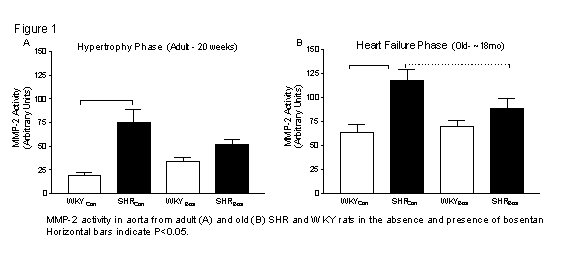| pA2 online © Copyright 2004 The British Pharmacological Society |
086P
GKT, University of London Winter Meeting December 2003 |
|
Aortic matrix
metalloproteinase activity in hypertension-induced hypertrophy:
transition to failure using spontaneously hypertensive rats |
|
Arterial remodelling, although initially an adaptive process, results in long-term fatiguing effects of the vessel wall due to alterations in the elastin-retaining network (Bohr et al., 1991). Matrix metalloproteinases (MMPs), responsible for degradation of connective tissue matrix are altered in heart failure (HF). However, little is known about the role of endothelin (ET) on changes in vascular MMP activity associated with development of hypertrophy and progression to failure. We investigated (i) alterations in MMP-2/9 activity and tissue inhibitor of matrix metalloproteinase (TIMP-1) expression during the development of hypertrophy, and transition to failure, using the spontaneously hypertensive rat (SHR), and (ii) determined the role of ET-1 in modulating MMP activity following chronic treatment with the mixed ETA/ETB receptor antagonist, bosentan.
Treatment with bosentan (100 mg/kg/day) was initiated (i) prior to development of hypertrophy (10wks), and maintained until a period when maximum hypertrophic effects were observed in untreated SHRs (20wks), and (ii) during a period of established hypertrophy, prior to development of HF (15mo), and maintained until HF (~18mo); age-matched Wistar Kyoto rats (WKY) were used as controls. Male SHR (n=11) and WKY rats (n=11) were randomly assigned to receive either placebo or bosentan, and animals were sacrificed under terminal anaesthesia using isoflurane. Aortic tissue was ground in liquid N2 and the protein extracted in a RIPA buffer; MMP activity was assessed by gelatin zymography, and TIMP-1 assessed by Western blot and ECL detection. Data were analysed by 2-way ANOVA with post hoc analysis (Bonferroni) and expressed as mean±s.e.m.; P<0.05 indicates statistical significance.

MMP-2 activity was 4 and 2 fold greater (P<0.05) in SHRs during hypertrophy and HF (Fig. 1A/B), respectively, compared with age-matched WKY. Chronic treatment of SHRs with bosentan abolished this increase only in HF (Fig. 1B). There was no change in the latent isoform (proMMP-2) during the hypertrophy phase; however, proMMP-2 was decreased (P<0.05) by 21% in bosentan-treated SHR (96±10au) compared with un-treated SHR (121±10au). MMP-9 and TIMP-1 were similar between SHR and WKY and were unaffected by treatment with bosentan in either age group.
In summary, these data demonstrate that (i) hypertrophy is associated with increased gelatinolytic activity by MMP-2, which is maintained, but attenuated, in HF, and (ii) chronic treatment with the mixed ETA/ETB receptor antagonist, bosentan, while appearing to attenuate the MMP-2 activity during hypertrophy, abolished changes during HF. In conclusion, ET receptors would appear to play a predominant role in vascular remodelling associated with MMPs during the transition from hypertrophy to failure.
Bohr, D., Dominiczak, A., & Webb, R. (1991). Hyperten., 18, S69-75.
Acknowledgements : Dr. M. Clozel (Actelion) for the gift of Bosentan.